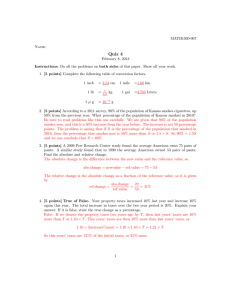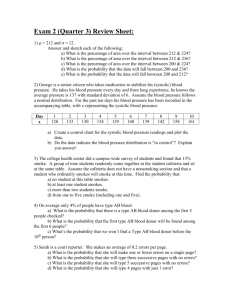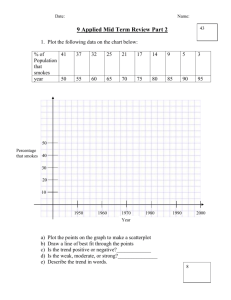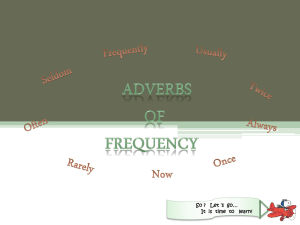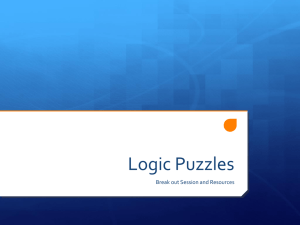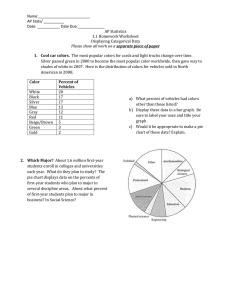Markov Logic Parag Singla Dept. of Computer Science University of Texas, Austin
advertisement
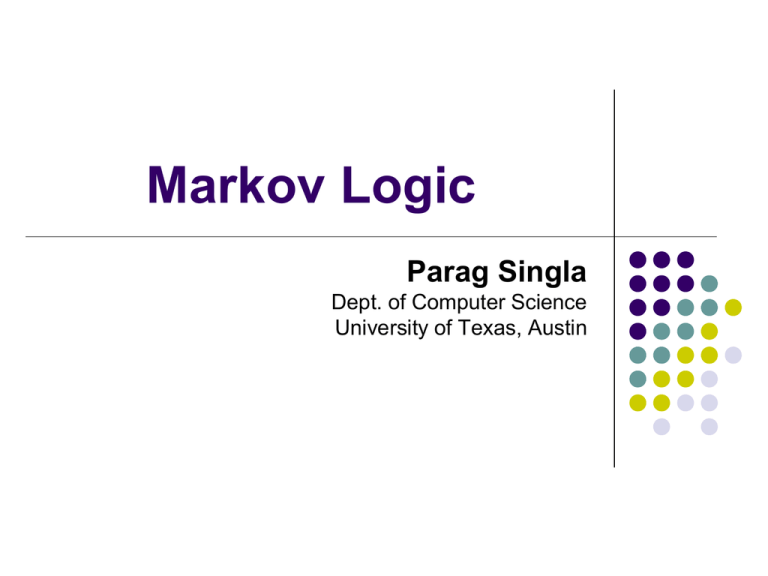
Markov Logic
Parag Singla
Dept. of Computer Science
University of Texas, Austin
Overview
Motivation
Background
Markov logic
Inference
Learning
Applications
The Interface Layer
Applications
Interface Layer
Infrastructure
Networking
WWW
Email
Applications
Interface Layer
Internet
Protocols
Infrastructure
Routers
Databases
ERP
CRM
Applications
OLTP
Interface Layer
Infrastructure
Relational Model
Transaction
Management
Query
Optimization
Artificial Intelligence
Planning
Robotics
Applications
NLP
Vision
Multi-Agent
Systems
Interface Layer
Representation
Inference
Infrastructure
Learning
Artificial Intelligence
Planning
Robotics
Applications
NLP
Vision
Interface Layer
Multi-Agent
Systems
First-Order Logic?
Representation
Inference
Infrastructure
Learning
Artificial Intelligence
Planning
Robotics
Applications
NLP
Vision
Interface Layer
Multi-Agent
Systems
Graphical Models?
Representation
Inference
Infrastructure
Learning
Artificial Intelligence
Planning
Robotics
Applications
NLP
Vision
Interface Layer
Multi-Agent
Systems
Statistical + Logical AI
Representation
Inference
Infrastructure
Learning
Artificial Intelligence
Planning
Robotics
Applications
NLP
Vision
Interface Layer
Multi-Agent
Systems
Markov Logic
Representation
Inference
Infrastructure
Learning
Overview
Motivation
Background
Markov logic
Inference
Learning
Applications
Markov Networks
Undirected graphical models
Smoking
Cancer
Asthma
Cough
Potential functions defined over cliques
1
P( x) c ( xc )
Z c
Z c ( xc )
x
c
Smoking Cancer
Ф(S,C)
False
False
4.5
False
True
4.5
True
False
2.7
True
True
4.5
Markov Networks
Undirected graphical models
Smoking
Cancer
Asthma
Cough
Log-linear model:
1
P( x) exp wi f i ( x)
Z
i
Weight of Feature i
Feature i
1 if Smoking Cancer
f1 (Smoking, Cancer )
0 otherwise
w1 1.5
First-Order Logic
Constants, variables, functions, predicates
Grounding: Replace all variables by constants
Smokes(x) Cancer(x)
Knowledge Base (KB): A set of formulas
Friends (Anna, Bob)
Formula: Predicates connected by operators
Anna, x, MotherOf(x), Friends(x,y)
Can be equivalently converted into a clausal form
World: Assignment of truth values to all ground
predicates
Overview
Motivation
Background
Markov logic
Inference
Learning
Applications
Markov Logic
A logical KB is a set of hard constraints
on the set of possible worlds
Let’s make them soft constraints:
When a world violates a formula,
It becomes less probable, not impossible
Give each formula a weight
(Higher weight Stronger constraint)
P(world) exp weights of formulas it satisfies
Definition
A Markov Logic Network (MLN) is a set of
pairs (F, w) where
F is a formula in first-order logic
w is a real number
Together with a finite set of constants,
it defines a Markov network with
One node for each grounding of each predicate in
the MLN
One feature for each grounding of each formula F
in the MLN, with the corresponding weight w
Example: Friends & Smokers
x Smokes( x) Cancer ( x)
x, y Friends ( x, y ) Smokes( x) Smokes( y )
Example: Friends & Smokers
1 .5
1 .1
x Smokes( x) Cancer ( x)
x, y Friends ( x, y ) Smokes( x) Smokes( y )
Example: Friends & Smokers
1 .5
1 .1
x Smokes( x) Cancer ( x)
x, y Friends ( x, y ) Smokes( x) Smokes( y )
Two constants: Ana (A) and Bob (B)
Example: Friends & Smokers
1 .5
1 .1
x Smokes( x) Cancer ( x)
x, y Friends ( x, y ) Smokes( x) Smokes( y )
Two constants: Ana (A) and Bob (B)
Smokes(A)
Cancer(A)
Smokes(B)
Cancer(B)
Example: Friends & Smokers
1 .5
1 .1
x Smokes( x) Cancer ( x)
x, y Friends ( x, y ) Smokes( x) Smokes( y )
Two constants: Ana (A) and Bob (B)
Friends(A,B)
Friends(A,A)
Smokes(A)
Smokes(B)
Cancer(A)
Friends(B,B)
Cancer(B)
Friends(B,A)
Example: Friends & Smokers
1 .5
1 .1
x Smokes( x) Cancer ( x)
x, y Friends ( x, y ) Smokes( x) Smokes( y )
Two constants: Ana (A) and Bob (B)
Friends(A,B)
Friends(A,A)
Smokes(A)
Smokes(B)
Cancer(A)
Friends(B,B)
Cancer(B)
Friends(B,A)
Example: Friends & Smokers
1 .5
1 .1
x Smokes( x) Cancer ( x)
x, y Friends ( x, y ) Smokes( x) Smokes( y )
Two constants: Ana (A) and Bob (B)
Friends(A,B)
Friends(A,A)
Smokes(A)
Smokes(B)
Cancer(A)
Friends(B,B)
Cancer(B)
Friends(B,A)
Example: Friends & Smokers
1 .5
1 .1
x Smokes( x) Cancer ( x)
x, y Friends ( x, y ) Smokes( x) Smokes( y )
Two constants: Ana (A) and Bob (B)
Friends(A,B)
Friends(A,A)
Smokes(A)
Smokes(B)
Cancer(A)
Friends(B,B)
Cancer(B)
Friends(B,A)
State of the World {0,1} Assignment to the nodes
Markov Logic Networks
MLN is template for ground Markov networks
Probability of a world x:
1
P( x) exp
wk f k ( x)
Z
kground formulas
One feature for each ground formula
1 if kth formula is satisfied given x
f k ( x)
otherwise
0
Markov Logic Networks
MLN is template for ground Markov nets
Probability of a world x:
1
P( x) exp
wk f k ( x)
Z
kground formulas
1
P( x) exp
wi ni ( x)
Z
iMLN formulas
Weight of formula i
No. of true groundings of formula i in x
Relation to Statistical Models
Special cases:
Markov networks
Markov random fields
Bayesian networks
Log-linear models
Exponential models
Max. entropy models
Gibbs distributions
Boltzmann machines
Logistic regression
Hidden Markov models
Conditional random fields
Obtained by making all
predicates zero-arity
Markov logic allows
objects to be
interdependent
(non-i.i.d.)
Relation to First-Order Logic
Infinite weights First-order logic
Satisfiable KB, positive weights
Satisfying assignments = Modes of distribution
Markov logic allows contradictions between
formulas
Markov logic in infinite domains
Overview
Motivation
Background
Markov logic
Inference
Learning
Applications
Inference
Friends(A,B)
Friends(A,A)
Smokes(A)?
Smokes(B)?
Cancer(A)
Friends(B,A)
Friends(B,B)
Cancer(B)?
Most Probable Explanation (MPE)
Inference
Friends(A,B)
Friends(A,A)
Smokes(A)?
Smokes(B)?
Cancer(A)
Friends(B,A)
Friends(B,B)
Cancer(B)?
What is the most likely state of Smokes(A), Smokes(B), Cancer(B)?
MPE Inference
Problem: Find most likely state of world
given evidence
arg max P( y | x)
y
Query
Evidence
MPE Inference
Problem: Find most likely state of world
given evidence
1
arg max
exp wi ni ( x, y )
Zx
y
i
MPE Inference
Problem: Find most likely state of world
given evidence
arg max
y
w n ( x, y)
i i
i
MPE Inference
Problem: Find most likely state of world
given evidence
arg max
y
w n ( x, y)
i i
i
This is just the weighted MaxSAT problem
Use weighted SAT solver
(e.g., MaxWalkSAT [Kautz et al. 97] )
Computing Probabilities: Marginal
Inference
Friends(A,B)
Friends(A,A)
Smokes(A)?
Smokes(B)?
Cancer(A)
Friends(B,A)
Friends(B,B)
Cancer(B)?
What is the probability Smokes(B) = 1?
Marginal Inference
Problem: Find the probability of query atoms
given evidence
P( y | x)
Query
Evidence
Marginal Inference
Problem: Find the probability of query atoms
given evidence
1
P( y | x)
exp wi ni ( x, y )
Zx
i
Computing Zx takes exponential time!
Belief Propagation
Bipartite network of nodes (variables)
and features
In Markov logic:
Nodes = Ground atoms
Features = Ground clauses
Exchange messages until convergence
Messages
Current approximation to node marginals
Belief Propagation
Smokes(Ana)
Nodes
(x)
Friends(Ana, Bob)
Smokes(Bob)
Smokes(Ana)
Features
(f)
Belief Propagation
x f ( x)
Nodes
(x)
h x
hn ( x ) \{ f }
( x)
Features
(f)
Belief Propagation
x f ( x)
Nodes
(x)
h x
hn ( x ) \{ f }
( x)
Features
(f)
wf ( x )
f x ( x) e
y f ( y )
~{ x}
yn ( f ) \{ x}
Lifted Belief Propagation
x f ( x)
Nodes
(x)
h x
hn ( x ) \{ f }
( x)
Features
(f)
wf ( x )
f x ( x) e
y f ( y )
~{ x}
yn ( f ) \{ x}
Lifted Belief Propagation
x f ( x)
Nodes
(x)
h x
hn ( x ) \{ f }
( x)
Features
(f)
wf ( x )
f x ( x) e
y f ( y )
~{ x}
yn ( f ) \{ x}
Lifted Belief Propagation
, :
Functions
of edge
counts
Nodes
(x)
x f ( x) h x ( x)
hn ( x ) \{ f }
Features
(f)
wf ( x )
f x ( x) e
y f ( y )
~{ x}
yn ( f ) \{ x}
Overview
Motivation
Background
Markov logic
Inference
Learning
Applications
Learning Parameters
w1?
w2?
x Smokes( x) Cancer ( x)
x, y Friends ( x, y ) Smokes( x) Smokes( y )
Three constants: Ana, Bob, John
Learning Parameters
x Smokes( x) Cancer ( x)
x, y Friends ( x, y ) Smokes( x) Smokes( y )
w1?
w2?
Three constants: Ana, Bob, John
Smokes
Smokes(Ana)
Smokes(Bob)
Learning Parameters
x Smokes( x) Cancer ( x)
x, y Friends ( x, y ) Smokes( x) Smokes( y )
w1?
w2?
Three constants: Ana, Bob, John
Smokes
Smokes(Ana)
Smokes(Bob)
Closed World Assumption:
Anything not in the database is assumed false.
Learning Parameters
x Smokes( x) Cancer ( x)
x, y Friends ( x, y ) Smokes( x) Smokes( y )
w1?
w2?
Three constants: Ana, Bob, John
Smokes
Cancer
Smokes(Ana)
Cancer(Ana)
Smokes(Bob)
Cancer(Bob)
Closed World Assumption:
Anything not in the database is assumed false.
Learning Parameters
x Smokes( x) Cancer ( x)
x, y Friends ( x, y ) Smokes( x) Smokes( y )
w1?
w2?
Three constants: Ana, Bob, John
Smokes
Cancer
Friends
Smokes(Ana)
Cancer(Ana)
Friends(Ana, Bob)
Smokes(Bob)
Cancer(Bob)
Friends(Bob, Ana)
Friends(Ana, John)
Friends(John, Ana)
Closed World Assumption:
Anything not in the database is assumed false.
Learning Parameters
Data is a relational database
Closed world assumption (if not: EM)
Learning parameters (weights)
Generatively
Discriminatively
Learning Parameters
(Discriminative)
Given training data
Maximize conditional likelihood of query (y)
given evidence (x)
Use gradient ascent
No local maxima
log Pw ( y | x) ni ( x, y ) Ew ni ( x, y )
wi
No. of true groundings of clause i in data
Expected no. true groundings according to model
Learning Parameters
(Discriminative)
Requires inference at each step (slow!)
log Pw ( y | x) ni ( x, y ) Ew ni ( x, y )
wi
No. of true groundings of clause i in data
Expected no. true groundings according to model
Approximate expected counts by counts in
MAP state of y given x
Learning Structure
Three constants: Ana, Bob, John
Smokes
Cancer
Friends
Smokes(Ana)
Cancer(Ana)
Friends(Ana, Bob)
Smokes(Bob)
Cancer(Bob)
Friends(Bob, Ana)
Friends(Ana, John)
Friends(John, Ana)
Can we learn the set of the formulas in the MLN?
Learning Structure
x Smokes( x) Cancer ( x)
x, y Friends ( x, y ) Smokes( x) Smokes( y )
w1?
w2?
Three constants: Ana, Bob, John
Smokes
Cancer
Friends
Smokes(Ana)
Cancer(Ana)
Friends(Ana, Bob)
Smokes(Bob)
Cancer(Bob)
Friends(Bob, Ana)
Friends(Ana, John)
Friends(John, Ana)
Can we refine the set of the formulas in the MLN?
Learning Structure
x Smokes( x) Cancer ( x)
x, y Friends ( x, y ) Smokes( x) Smokes( y )
w1?
w2?
Three constants: Ana, Bob, John
Smokes
Cancer
Friends
Smokes(Ana)
Cancer(Ana)
Friends(Ana, Bob)
Smokes(Bob)
Cancer(Bob)
Friends(Bob, Ana)
Friends(Ana, John)
Friends(John, Ana)
w3? x, y Friends ( x, y ) Friends ( y, x )
Learning Structure
Learn the MLN formulas given data
Search in the space of possible formulas
Exhaustive search not possible!
Need to guide the search
Initial state: Unit clauses or hand-coded KB
Operators: Add/remove literal, flip sign
Evaluation function:
likelihood + structure prior
Search: top-down, bottom-up, structural motifs
Overview
Motivation
Markov logic
Inference
Learning
Applications
Conclusion & Future Work
Applications
Web-mining
Collective Classification
Link Prediction
Information retrieval
Entity resolution
Activity Recognition
Image Segmentation &
De-noising
Social Network
Analysis
Computational Biology
Natural Language
Processing
Robot mapping
Planning and MDPs
More..
Entity Resolution
Data Cleaning and Integration – first step in
the data-mining process
Merging of data from multiple sources results
in duplicates
Entity Resolution: Problem of identifying
which of the records/fields refer to the same
underlying entity
Entity Resolution
Author
Title
Venue
Parag Singla and Pedro Domingos, “Memory-Efficient
Inference in Relational Domains” (AAAI-06).
Singla, P., & Domingos, P. (2006). Memory-efficent
inference in relatonal domains. In Proceedings of the
Twenty-First National Conference on Artificial Intelligence
(pp. 500-505). Boston, MA: AAAI Press.
H. Poon & P. Domingos, Sound and Efficient Inference
with Probabilistic and Deterministic Dependencies”, in
Proc. AAAI-06, Boston, MA, 2006.
Poon H. (2006). Efficent inference. In Proceedings of the
Twenty-First National Conference on Artificial Intelligence.
Entity Resolution
Author
Title
Venue
Parag Singla and Pedro Domingos, “Memory-Efficient
Inference in Relational Domains” (AAAI-06).
Singla, P., & Domingos, P. (2006). Memory-efficent
inference in relatonal domains. In Proceedings of the
Twenty-First National Conference on Artificial Intelligence
(pp. 500-505). Boston, MA: AAAI Press.
H. Poon & P. Domingos, Sound and Efficient Inference
with Probabilistic and Deterministic Dependencies”, in
Proc. AAAI-06, Boston, MA, 2006.
Poon H. (2006). Efficent inference. In Proceedings of the
Twenty-First National Conference on Artificial Intelligence.
Entity Resolution
Author
Title
Venue
Parag Singla and Pedro Domingos, “Memory-Efficient
Inference in Relational Domains” (AAAI-06).
Singla, P., & Domingos, P. (2006). Memory-efficent
inference in relatonal domains. In Proceedings of the
Twenty-First National Conference on Artificial Intelligence
(pp. 500-505). Boston, MA: AAAI Press.
H. Poon & P. Domingos, Sound and Efficient Inference
with Probabilistic and Deterministic Dependencies”, in
Proc. AAAI-06, Boston, MA, 2006.
Poon H. (2006). Efficent inference. In Proceedings of the
Twenty-First National Conference on Artificial Intelligence.
Predicates
HasToken(field,token)
HasField(record,field)
SameField(field,field)
SameRecord(record,record)
Predicates & Formulas
HasToken(field,token)
HasField(record,field)
SameField(field,field)
SameRecord(record,record)
HasToken(f1,t) HasToken(f2,t) SameField(f1,f2)
(Similarity of fields based on shared tokens)
Predicates & Formulas
HasToken(field,token)
HasField(record,field)
SameField(field,field)
SameRecord(record,record)
HasToken(f1,t) HasToken(f2,t) SameField(f1,f2)
(Similarity of fields based on shared tokens)
HasField(r1,f1) HasField(r2,f2) SameField(f1,f2)
SameRecord(r1,r2)
(Similarity of records based on similarity of fields and
vice-versa)
Predicates & Formulas
HasToken(field,token)
HasField(record,field)
SameField(field,field)
SameRecord(record,record)
HasToken(f1,t) HasToken(f2,t) SameField(f1,f2)
(Similarity of fields based on shared tokens)
HasField(r1,f1) HasField(r2,f2) SameField(f1,f2)
SameRecord(r1,r2)
(Similarity of records based on similarity of fields and
vice-versa)
SameRecord(r1,r2) ^ SameRecord(r2,r3) SameRecord(r1,r3)
(Transitivity)
Predicates & Formulas
HasToken(field,token)
HasField(record,field)
SameField(field,field)
SameRecord(record,record)
HasToken(f1,t) HasToken(f2,t) SameField(f1,f2)
(Similarity of fields based on shared tokens)
HasField(r1,f1) HasField(r2,f2) SameField(f1,f2)
SameRecord(r1,r2)
(Similarity of records based on similarity of fields and
vice-versa)
SameRecord(r1,r2) ^ SameRecord(r2,r3) SameRecord(r1,r3)
(Transitivity)
Winner of Best Paper Award!
Discovery of Social Relationships
in Consumer Photo Collections
Find out all the photos of my child’s friends!
MLN Rules
Hard Rules
Two people share a unique relationship
Parents are older than their children
…
Soft Rules
Children’s friends are of similar age
Young adult appearing with a child shares a
parent-child relationship
Friends and relatives are clustered together
…
Models Compared
Model
Description
Random
Random prediction (uniform)
Prior
Prediction based on priors
Hard
Hard constraints only
Hard-prior
Combination of hard and prior
MLN
Hand constructed MLN
Results (7 Different Relationships)
Alchemy
Open-source software including:
Full first-order logic syntax
MPE inference, marginal inference
Generative & discriminative weight learning
Structure learning
Programming language features
alchemy.cs.washington.edu
